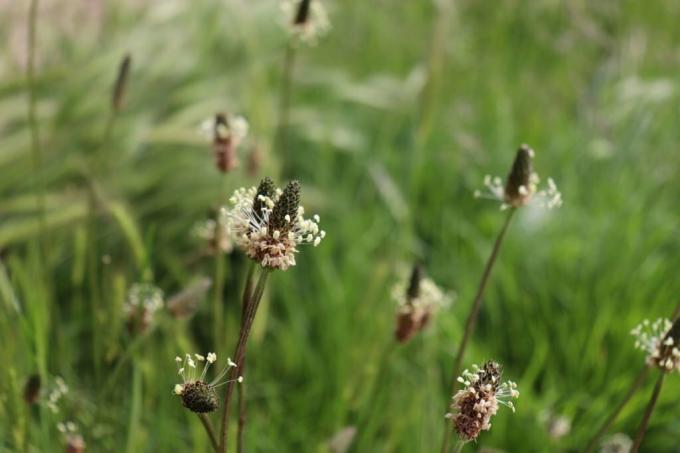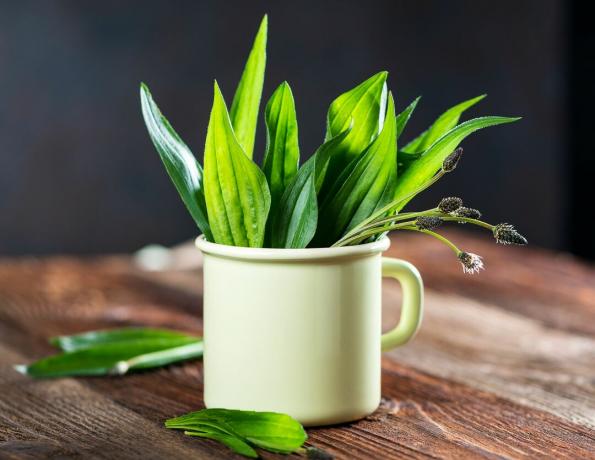Ribwort plantain is known from walks on wild meadows. We show that the supposed weed can also be used as a medicinal plant.

Much of what appears to be weeds is actually extremely useful. Ribwort plantain (Plantago lanceolata) is even cultivated specifically by many a farmer. But why is this plant worth the effort? The ribwort is a constant companion on almost all of our meadows and in grassland, if you just take a closer look. The plant is not only a promising medicinal plant, it also has a lot to offer in the kitchen. But read for yourself.
contents
- Ribwort plantain: origin and characteristics
- Buy ribwort
- Grow ribwort
- Propagate ribwort
- Maintain ribwort
- Harvest and store ribwort
- Ribwort plantain: use as a medicinal plant
- Use ribwort in the kitchen
Ribwort plantain: origin and characteristics
Ribwort plantain comes from the Eurasian continent and its home is also here in Germany. It started its triumphal march from this continent and conquered the whole earth, so that it can be found almost everywhere today. Its leaves are provided with veins that run parallel to each other, the shape of which is long, pointed and lanceolate. They are arranged in a rosette, from the center of which a long, bare stem with a short inflorescence often protrudes.
Buy ribwort
The herb of the ribwort is grown extensively in agriculture. From time to time you can therefore buy fresh ribwort in the shop. But it is also often available as a pot herb in the supermarket. However, if you own a garden with a meadow, you usually have enough ribwort in your own garden to dig up young plants or harvest the seeds. Plantain specimens from nature are more resilient and better adapted to local conditions than purchased plants.
Grow ribwort
Ribwort plantain is a plant that loves sun and warmth. He feels comfortable on fresh and humus soil, especially when it is slightly acidic. You can sow the seeds before winter in August or September, or in the New Year between March and April. After sowing, cover the seeds with soil so that they are about 1.5 to 2 centimeters deep. After about 14 days you will be able to see the first green. Can be harvested as soon as the plants are large enough. Pick a few leaves every now and then. In the summer, you can even cut off whole tufts to use larger quantities in the kitchen, for example. After pruning, the ribwort sprouts fresh with young leaves.
Propagate ribwort
In the meadow and along the way, the ribwort reproduces all by itself. Just examine one square meter of a meadow and you will be amazed at how many ribwort plants you will discover. They multiply by forming new leaf rosettes that gradually become independent. And at some point they are completely independent of the mother plant. Planted ribwort also show this behavior. However, if that doesn't go fast enough for you, you can simply extract the seeds by wiping them off the ripe ears of a plant and then sowing them where you want them.

Maintain ribwort
The easiest way, of course, is to harvest your ribwort plantain as a weed straight from the meadow. That makes maintenance superfluous. However, if you live in the city or have dog walks in the vicinity, you might prefer to grow ribwort in a bed, pot or balcony box. But even in this case the ribwort is pretty straightforward. Rainwater is sufficient when planted in the bed and a little fresh compost or manure in the spring. In the pot, you should also water the plants regularly so that the soil never dries out. The ribwort, however, does not like waterlogging at all.
Harvest and store ribwort
The ribwort sprouts freshly after it has been cut back. In its thick root it has enough resources stored to dare to start again with a lot of energy. No wonder, because ribwort is often found on pastures where it is regularly completely gnawed off by cows, sheep or horses.
You should harvest the leaves of the plant while they are still young. Older leaves become tough and the leaf veins, which are nicely arranged parallel to one another, quickly become stubborn threads between the teeth. The leaves taste best when they are young and tender. If you don't want to use the leaves straight away, it is best to keep them cool and airtight. The leaves stay crisp longer in a paper bag or, even better, in a plastic bag than in the fresh air.
If it is more than a few days, you should of course choose other means of storage. One option is to dry the leaves for use as tea. You can also use it to make pesto or even freeze it, for example if you feel the need for fresh ribwort plantain spinach in winter.
Ribwort plantain: use as a medicinal plant
The beneficial properties of the ribwort have been known for a long time. The good thing is that this incredibly useful plant grows pretty much anywhere. Even with so many painful wasp or bee stings at the bathing lake, this wonderful plant has been able to provide a direct remedy. Usually the next ribwort grows right next door. One or two leaves are enough and should be lightly chewed. The mass must then be applied directly to the stitch and remain there for a few minutes. And then the pain-relieving and healing properties of the ribwort unfold. You can do the same for wounds and inflammations. Aucubin, an ingredient of the ribwort, which inhibits inflammation and soothes stimuli, is responsible for this.
The ribwort also provides a remedy for coughing. The mucous substances contained in the leaves cover the attacked mucous membranes and protect and soothe them. Brew a fresh cough tea from six to seven fresh leaves or two tablespoons of dried leaves in one liter of water and let it steep for ten minutes. Incidentally, the tea not only helps against coughs, but is also said to be blood-purifying. Once cooled, it can even be used to wash out irritated eyes.

Ribwort plantain honey is very tasty and healthy. Soak young plantain leaves in honey for three months. After removing the leaves, you will get a wonderful spread that also strengthens the immune system.
Summary ribwort as a medicinal plant:
- For stings and sores
- Against coughs and irritated mucous membranes
- As a blood purifier
- To strengthen the immune system
- To prevent and relieve blisters (more on this in this Article on plantain)
Use ribwort in the kitchen
Ribwort plantain is much more vigorous than its closely related broad plantain. This makes its healthy leaves ideal for consumption. Of course, you can also use the seeds and roots as in the Article on plantain use described in the kitchen. The leaves of the ribwort can be processed in a variety of ways. Obviously, of course, is spicy pesto made from young leaves, as you would get it from Wild garlic, parsley and basil knows. Try something new and just use ribwort.
Ribwort plantain also tastes very good mixed in with salad. If you want it a little more intense, there is of course also the pure form: ribwort plantain spinach. Simply cooked with pure spinach or with a little cream, this dish tastes wonderful with potatoes and scrambled eggs.
More about the close relative of the ribwort, the Plantain, we have also prepared for you in this article.



